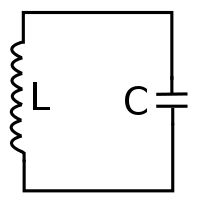|
Experiment 3: LC Circuit. |
|
LC circuits The second order differential equation governing the current i(t) in the LC circuit is
Thus, the complete solution to the differential equation is
The resonant frequency of the LC circuit is
Details relating to operation of the LC circuits can be found at the link below http://en.wikipedia.org/wiki/LC_circuit
Please feel free to send your feedback, suggestions or queries regarding the experiment to: oscillations.vlab@gmail.com In your email, please mention the experiment no. and name of the experiment. |


|
Developed and maintained by: Satyajit Banerjee, Pabitra Mandal and Gorky Shaw |
|
Procedure for downloading and running programs offline: · To download the programs, right click on the link above and choose ‘save target as’, or, ‘save link as’ depending on the browser. · Save the ‘.zip’ file to any directory on your PC. · Extract the ALL contents of the .zip file to the SAME folder. · Double click on the file “LC.exe” to start executing the program. · After this, perform the experiment as demonstrated in the video instructions provided in the link below. |

